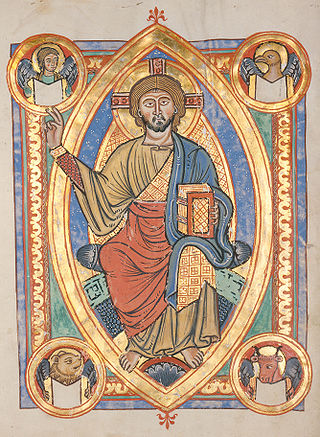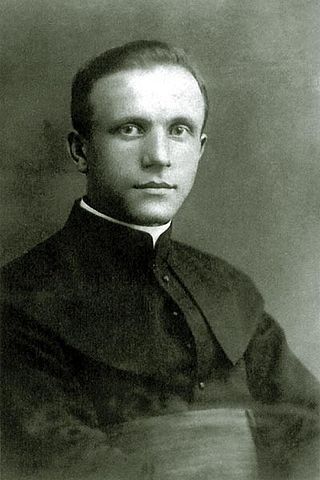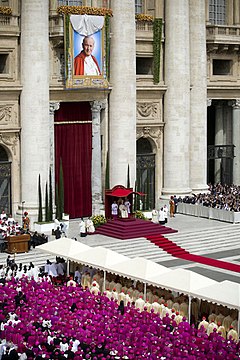
In the teaching of the Catholic Church, an indulgence is "a way to reduce the amount of punishment one has to undergo for (forgiven) sins". The Catechism of the Catholic Church describes an indulgence as "a remission before God of the temporal punishment due to sins whose guilt has already been forgiven, which the faithful Christian who is duly disposed gains under certain prescribed conditions…"

Mercy is benevolence, forgiveness, and kindness in a variety of ethical, religious, social, and legal contexts.

The Great Jubilee in 2000 was a major event in the Catholic Church, held from Christmas Eve 1999 to Epiphany 2001. Like other previous Jubilee years, it was a celebration of the mercy of God and forgiveness of sins. The major innovation in this Jubilee was the addition of many "particular Jubilees" for various groups of persons, and that it was simultaneously celebrated in Rome, Israel, and elsewhere in the world.

In Catholicism, the Divine Mercy is a devotion to Jesus Christ associated with the reported apparitions of Jesus to Faustina Kowalska.

The image of the Divine Mercy is a depiction of Jesus Christ that is based on the Divine Mercy devotion initiated by Faustina Kowalska.

The Chaplet of the Divine Mercy, also called the Divine Mercy Chaplet, is a Catholic devotion to the Divine Mercy, based on the Christological apparitions of Jesus reported by Faustina Kowalska (1905–1938), known as "the Apostle of Mercy". She was a Polish religious sister of the Congregation of the Sisters of Our Lady of Mercy and canonized as a Catholic saint in 2000.

Catholic devotions are particular customs, rituals, and practices of worship of God or honour of the saints which are in addition to the liturgy of the Catholic Church. The United States Conference of Catholic Bishops describes devotions as "expressions of love and fidelity that arise from the intersection of one's own faith, culture and the Gospel of Jesus Christ". Devotions are not considered part of liturgical worship, even if they are performed in a church or led by a priest, but rather they are paraliturgical. The Congregation for Divine Worship at the Vatican publishes a Directory on Popular Piety and the Liturgy.

Holy Hour is the Roman Catholic devotional tradition of spending an hour in Eucharistic adoration in the presence of the Blessed Sacrament. A plenary indulgence is granted for this practice. The practice is also observed in some Lutheran churches and some Anglican churches.
The concept of a victim soul is an unofficial belief derived from interpretations of the Catholic Church teachings on redemptive suffering. A person believes themselves or is considered by others to be chosen by God to suffer more than most, accepting this condition based on the example of Christ's own Passion. Neither the Catholic Church, nor any other Christian denomination, officially designates anyone as a victim soul. As it is not considered dogma, the Church classifies belief in victim souls as a matter of private revelation and thus not obligatory for members to subscribe to.

The Roman Catholic tradition includes a number of devotions to Jesus Christ. Like all Catholic devotions, these prayer forms are not part of the official public liturgy of the church but are based on the popular spiritual practices of Roman Catholics. Many are officially approved by the Holy See as suitable for spiritual growth but not necessary for salvation.

A number of prayers to Jesus Christ exist within the Roman Catholic tradition. These prayers have diverse origins and forms. Some were attributed to visions of saints, others were handed down by tradition.

Maria Faustyna Kowalska, OLM, also known as Maria Faustyna Kowalska of the Blessed Sacrament, was a Polish Catholic religious sister and mystic. Faustyna, popularly spelled "Faustina", had apparitions of Jesus Christ which inspired the Catholic devotion to the Divine Mercy and earned her the title of "Secretary of Divine Mercy".

The Divine Mercy Shrine in Kraków, Poland, is a Roman Catholic basilica dedicated to the Divine Mercy devotion, and is the resting place of Faustina Kowalska, canonised by the Catholic Church on 30 April 2000.

The Divine Mercy Sanctuary of Vilnius or the Holy Trinity Church is a shrine in Vilnius dedicated to the Divine Mercy, a devotion originated by Faustina Kowalska.

The Divine Mercy Sanctuary is a Roman Catholic chapel, in Poland, dedicated to the Divine Mercy devotion, originated by Faustina Kowalska.

Michael Sopoćko was a Polish Roman Catholic priest and professor at Vilnius University. He is best known as the spiritual director of Faustina Kowalska. He was beatified by Pope Benedict XVI in 2008.

Eugeniusz Marcin Kazimirowski was a Polish painter, and member of the realism movement. He is best known for the first depiction of the Divine Mercy image in 1934, based on a request from Faustyna Kowalska and her confessor Michael Sopoćko.
A notification by the Holy See is an official announcement by a department of the Holy See, the leadership of the Catholic Church in Rome.

Holy Rosary Church is a Roman Catholic church located within the Archdiocese of Baltimore in Baltimore, Maryland. It was established to serve Baltimore's Polish community.
The Second Sunday of Easter is the eighth day of the Christian season of Eastertide, and the seventh after Easter Sunday. It is known by various names, including Divine Mercy Sunday, the Octave Day of Easter, White Sunday, Quasimodo Sunday, Bright Sunday and Low Sunday. In Eastern Christianity, it is known as Antipascha, New Sunday, and Thomas Sunday.


















